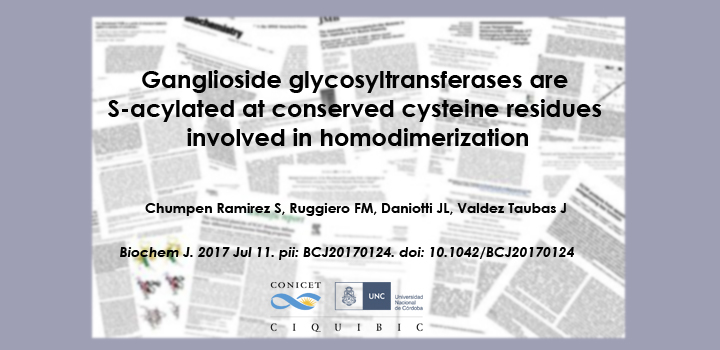Chumpen Ramirez S et at, Biochem J., 2017
Ganglioside glycosyltransferases (GGTs) are type-II membrane proteins bearing a short N-terminal cytoplasmic tail, a transmembrane domain (TMD), and a lumenal catalytic domain. The expression and activity of these enzymes largely determine the quality of the glycolipids that decorate mammalian cells membranes. Many glycosyltransferases are themselves glycosylated and this is important for their proper localisation, but few if any other post-translational modifications of these proteins have been reported. Here we show that the GGTs, ST3Gal-V, ST8Sia-I, and β4GalNAcT-I are S-acylated at conserved cysteine residues located close the cytoplasmic border of their TMDs. ST3Gal-II, a GT that sialylates glycolipids and glycoproteins, is also S-acylated at a conserved cysteine located in the N-terminal cytoplasmic tail. Many others GTs also possess cysteine residues in their cytoplasmic regions suggesting that this modification occurs on these GTs as well. S-acylation, commonly known as palmitoylation, is catalysed by a family of palmitoyltransferases (PATs) that are mostly localised at the Golgi complex but also at the endoplasmic reticulum (ER) and the plasma membrane. Using GT’s ER-retention mutants, we found that S-acylation of β4GalNAcT-I and ST3Gal-II takes place at different compartments, suggesting that these enzymes are not substrates of the same PAT. Finally, we found that cysteines that are the target of S-acylation on β4GalNAcT-I and ST3Gal-II are involved in the formation of homodimers through disulphide bonds. We observed an increase of ST3Gal-II dimers in the presence of the PAT inhibitor 2-bromopalmitate, suggesting that GTs homodimerization may be regulating S-acylation.
Autores: Chumpen Ramirez S, Ruggiero FM, Daniotti JL, Valdez Taubas J (link a Valdez)
Artículo: Chumpen Ramirez S et al. Biochem J. 2017 Jul 11. pii: BCJ20170124. doi: 10.1042/BCJ20170124



